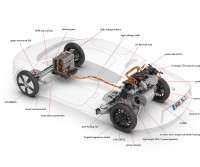
Unless you have an off-road or 4×4 vehicle, you likely never think about how your car’s power gets to the road. This is called your drivetrain, and it describes which wheels on your car receive power in order to move it forward. It matters a lot for understanding car marketing, maintenance, and how to drive in severe weather!
The last part isn’t as much of a concern here in North Carolina’s triangle, but it’s still important for the occasional blizzard or downpour. The first two matter year round, and make you a smarter consumer! Today we’ll talk about major kinds of drivetrains.
Front-Wheel Drive
Front-wheel drive – or FWD – is by far the most common drivetrain. This layout connects your engine to your front wheels, with the rear wheels rotating freely. FWD emerged in the 70s and 80s due to the compact layout – perfect for small cars during the fuel crisis – and lower building costs.
FWD cars do not easily spin out, making them ideal for the average driver. Engine weight over the drive wheels also makes them better than rear-wheel drive for bad weather. However, FWD cars struggle with high power engines and precision turning, making them a poor choice for sports cars. Exceptions to this rule include “sport compact” cars like the Volkswagen GTI.
Front-wheel drive cars have one unique maintenance item: CV axles. These complex mechanisms can wear out over time, and cost several hundred dollars to replace.
Rear-Wheel Drive
Rear-wheel drive (RWD) cars are the oldest type of drivetrain. They send power through a fast-spinning driveshaft to a differential that drives the rear wheels. Your steering remains in the front.
Rear-wheel drive is capable of much more power than front-wheel drive. As a result, it’s the layout of choice for sports cars, luxury cars, and trucks. However, RWD cars do not have the traction benefits of FWD, making them exceptionally poor choices for severe weather.
Unique RWD maintenance is mainly centered on the differential. Its fluid may need to be regularly changed.
Four-Wheel and All-Wheel Drive
Four-wheel (4WD) and all-wheel drive (AWD) operate on the same principle: applying power to all four wheels of a car. They differ in their marketing. 4WD is usually a part-time feature that the driver can turn on or off, like in many SUVs. AWD is usually on full-time (as in most Subarus) or activates when the car detects a loss of traction (like in the Honda Pilot or Nissan Rogue).
AWD and 4WD have superior traction in bad weather, allowing even the weakest engine to work its way out of snow. However, full-time setups lessen gas mileage, and even part-time setups add fuel-guzzling weight.
Full-time AWD cars must have their tires rotated regularly; uneven tread can cause the drive system to break. All setups may require regular changing of differential fluid.
Does your SUV, sports car or family sedan need maintenance? Fast Lube Plus offers service to all vehicles in the Triangle area. Call us today or drop by!
